From the Vault: The top ten: “20th century”…
November 21, 2025 by TimHughes · 9 Comments
From this period in newspaper publishing history, displayability has much to do with the desirability of a newspaper, perhaps more so than historical significance. Since I come to this task of listing the “top ten” from the perspective of a rare newspaper dealer and knowing the requests we receive for certain events, the following list may not be the same as my most “historic” but they are my thoughts for the most “desirable” based on customer demand. Certainly FDR’s New Deal is more historically significant than the death of Bonnie & Clyde, but not more desirable from a collector standpoint. I’d be curious to hear of your thoughts.
 Here they are, beginning with number ten:
Here they are, beginning with number ten:
10) St. Valentine’s Day Massacre, Feb. 14, 1929 An issue with a dramatic banner headline, & ideally dated the 14th. Morning papers would be dated the 15th.
9) Death of Bonnie & Clyde, May 23, 1934 The gangster era remains much in demand, & perhaps due to the movie this event beats out Dillinger, Capone & the others from the era. A dramatic headline drives desirability–ideally with a photo–even if not in a Louisiana newspaper.
8.) Charles Lindbergh flies the Atlantic, May 22, 1927 The New York Times had a nice headline account with a map of the route, and the prestige of the newspaper always keeps it in high demand.
 7) Call-Chronicle-Examiner, San Francisco, April 19, 1906 I note a specific title & date for this event, as these 3 newspapers combined to produce one 4 page newspaper filled with banner heads & the latest news. No advertisements.
7) Call-Chronicle-Examiner, San Francisco, April 19, 1906 I note a specific title & date for this event, as these 3 newspapers combined to produce one 4 page newspaper filled with banner heads & the latest news. No advertisements.
6) Crash of the Hindenberg, May 6, 1937 The more dramatic the headline the better, & ideally with the Pulitizer Prize winning photo of the airship in flames.
5) Wright brothers fly, Dec. 17, 1903 Here’s where the significance of the event drives desirability over dramatic appeal. Few can argue the impact of manned flight on the world. Reports were typically brief & buried on an inside page with a small headline, so a lengthy front page report would be in top demand.
4) Stock market crash, October, 1929 Demand is driven by the dramatic headline and its wording. Too many newspapers tried to put an optimistic spin on the tragedy. Collectors want “collapse, disaster, crash” & similarly tragic words in the headline (how about Variety magazine’s: “Wall Street Lays On Egg”?)
 3) Honolulu Star-Bulletin, Dec. 7, 1941 “1st Extra” The defining issue from World War II but be careful of reprints as most issues on the market are not genuine.
3) Honolulu Star-Bulletin, Dec. 7, 1941 “1st Extra” The defining issue from World War II but be careful of reprints as most issues on the market are not genuine.
2) Chicago Daily Tribune, Nov. 3, 1948 “Dewey Defeats Truman”. What more need be said?
1) Titanic sinking, April 14, 1912 Certainly low on the historically significant list, but off the charts on the desirability scale, much due to the block-busting movie. The more dramatic the headline the better, and hopefully with a nice illustration of the ship going down.
My “honorable mention” list might include baseball’s “Black Sox” scandal of 1919, sinking of the Lusitania, end of World War II, D-Day, JFK’s election, the New Deal, a great Babe Ruth issue, etc. Maybe they would rank higher on your list. Feel free to share your top choices.
The reason I collected it: the Nuremberg trials…
November 3, 2025 by TimHughes · Leave a Comment
I have likely stated several times that part of the quest in seeking the best report of a notable event is to find it in a newspaper as close to where it happened as possible. For the death of JFK, a Dallas newspaper is best. On the bombing of Pearl Harbor, a Honolulu newspaper is great. On the Boston Massacre in 1770, a Boston paper would be wonderful.
Some events can be extremely difficult, so you do the best you can. How about when man walked on the moon? Outside of a lunar publication that did not exist, a newspaper from Neil Armstrong’s hometown is pretty good. Or perhaps one from close to Cape Canaveral.
One of the more notable events at the conclusion of World War II was the Nuremberg Trials. There were 22 defendants held for war crimes; 12 would hang, 7 served time, and 3 found not guilty.
But finding a German newspaper with this report had eluded us. And as is the case with events in foreign language countries, a report close to the event would be diminished a bit if the text is in a language other than English. Not many desire a newspaper they cannot read.
But as luck would have it, a Nuremberg suburb–Furth–had a former Nazi air base, captured by American forces in early April, 1945 & converted to a U.S. air base. And better yet, it produced a small, obviously low-circulation newspaper called “The Jet Gazette”. The October 1, 1946 issue was devoted to the results of the trials. And being an American air base, it’s in English. It was a great find that I suspected never existed!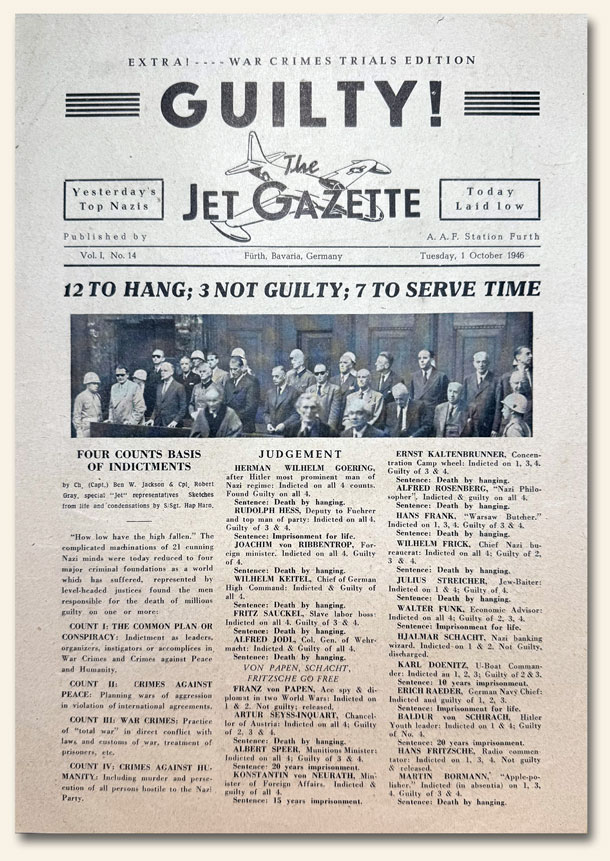
From the Vault: Headlines drive interest in World War II…
October 24, 2025 by TimHughes · Leave a Comment
For likely a multitude of reasons, interest in World War II newspapers ranks far higher than in the Korean War, World War I, or the Spanish-American War. It may be a generational thing, as most collectors today are children of World War II veterans and likely heard stories of the war first-hand, or found  newspapers in their parents attics which sparked an interest. One could debate a number of other possible reasons why other wars lack the intrigue found in that fought by the “greatest generation”.
newspapers in their parents attics which sparked an interest. One could debate a number of other possible reasons why other wars lack the intrigue found in that fought by the “greatest generation”.
Headline collecting has always been a focus for this hobby, and as any collector knows, bold, banner headlines did not become commonplace until late in the 19th century. With the increasing competitiveness of daily newspapers across the country–Hearst, Pulitzer & others rising to prominence–flashier front pages were needed to draw attention at the corner news stand. It’s a shame there is not more interest in the Spanish-American War and World War I as both events resulted in some huge, dramatic, & very displayable headlines.
Because there are a plethora of newspapers from the WWII era available, collectors have become very discriminating in what they collect. Only the “best of the best” will do, meaning just the major events and only those with huge and displayable headlines. If there is a “top 6” list of sought-after events, our experience is they would be: 1) attack on Pearl Harbor; 2) the D-Day invasion; 3) death of Hitler; 4) end of the war in Europe; 5) dropping of the atomic bomb; 6) end of the war in the Pacific. One could add any number of other battle reports such as Midway, battle of the Bulge, fall of Italy, Iwo Jima, battle for Berlin, and so much more. And we could step back before American involvement in the war and add Hitler’s invasion of Poland and the battle of Britain.
The bigger the headline the better. With some newspapers the entire front page was taken up with a headline and a related graphic. The U.S. flag was a common patriotic device. Tabloid-size newspapers commonly had the front page entirely taken up with a singular headline and tend to be better for display given their smaller size.
 And not just American newspapers draw interest. German newspapers hold a special intrigue, but the language barrier is a problem for many. But the British Channel Islands, located in the English Channel between England & France, were occupied by the Nazi during the war so their reports were very pro-Nazi while printed in the English language (ex., Guernsey Island). And the military newspaper “Stars and Stripes“, while certainly being American, was published at various locations in Europe and the Pacific. Collectors have a special interest in finding World War II events in the official newspapers of the American military forces. Plus there were a multitude of “camp” newspapers, amateur-looking newspapers printed on a mimeograph machine for consumption limited to a military base, and typically printed is very small quantities. Their rarity is not truly appreciated by many.
And not just American newspapers draw interest. German newspapers hold a special intrigue, but the language barrier is a problem for many. But the British Channel Islands, located in the English Channel between England & France, were occupied by the Nazi during the war so their reports were very pro-Nazi while printed in the English language (ex., Guernsey Island). And the military newspaper “Stars and Stripes“, while certainly being American, was published at various locations in Europe and the Pacific. Collectors have a special interest in finding World War II events in the official newspapers of the American military forces. Plus there were a multitude of “camp” newspapers, amateur-looking newspapers printed on a mimeograph machine for consumption limited to a military base, and typically printed is very small quantities. Their rarity is not truly appreciated by many.
For obvious reasons, there is also a high degree of collectible interest from those wishing to make sure certain aspects of history are not forgotten. The Holocaust, and the Nazi propaganda used to provide a rationale for eliminating the Jewish people, is well documented in newspapers from the era. In addition to the Holocaust and its atrocities, issues providing context through reporting other pre-war events such as the Great Depression, fascism, and increased militarism, are also desirable.
True to any collectable field, newspaper collectors are always on the lookout for an issue better than what they have, and collection upgrades are constant. Finding that special, rare, unusual or fascinating headline is what makes the hobby fun. Will interest in the Korean War and the Vietnam War gain more interest in future years? Perhaps so. With interest currently low and availability and prices very attractive, it might be a good time to explore.
The reason I collected it: a single-focus newspaper…
October 13, 2025 by TimHughes · 1 Comment
The general rule for a newspaper of any era is to report the news of the day on a regular basis, typically daily or weekly. Some have a thematic focus whether it be the slavery issue, the military, masonic events, etc., but even such newspapers maintained a history of publishing on a regular basis.
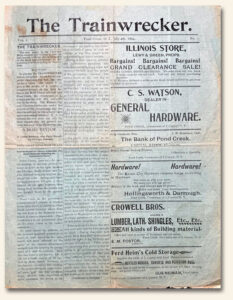 I don’t believe we have previously discovered a newspaper that had a singular focus on a specific event until we acquired “The Trainwrecker” from Pond Creek, Oklahoma Territory, 1894. This is not just a rare title; this could be a unique issue being the volume 1, number 1 issue of a newspaper about which nothing can be found. It is not listed in Gregory’s “Union List of Newspapers”, nor have we found anything on the internet.
I don’t believe we have previously discovered a newspaper that had a singular focus on a specific event until we acquired “The Trainwrecker” from Pond Creek, Oklahoma Territory, 1894. This is not just a rare title; this could be a unique issue being the volume 1, number 1 issue of a newspaper about which nothing can be found. It is not listed in Gregory’s “Union List of Newspapers”, nor have we found anything on the internet.
Its purpose is noted on the front page, and it seems to have a singular focus: the dispute the Pond Creek area had with the Rock Island Railroad.
As a bit of background, I might encourage a visit to “Hell on Rails: Oklahoma Towns at War with the Rock Island Railroad“, which details the backdrop for why this newspaper was created. It is rather convoluted and relates much to how the Indian Territory, now Oklahoma, was settled and how the railroads were a factor in town settlements.
The issue begins with: “The only paper in the Cherokee Strip capable and willing to take up and handle without gloves the action of the Rock Island Railroad, in the pursuance of their policy to rule or ruin.”
Then the “Salutary” begins: “In placing the TRAINWRECKER before the public, we ask for no sympathy–realizing full well the step we have taken. Our object is to give to the people of L county a complete account of the fight between the Rock Island railroad and Pond Creek, the county seat of L county and the only live, energetic city in the Strip…” with much more not just on the front page but on inside pages as well.
It is possible this newspaper existed for just this one issue, but without documenting records we cannot confirm. Printed as it is on green paper, it certainly doesn’t seem as though the publisher planned for a lengthy run.
This is part of the fascination with rare titles, as their scarcity simply implies a lack of information. Although we have encountered other newspapers that failed to exist beyond just a few issues, this is the first that seems to have existed to exploit a singular concern.
Personal note from Guy: “If historical fiction is within your wheelhouse of interests, I found ‘The Assassin’ and ‘The Wrecker’, both by Clive Cussler, fun reads. The former focuses more on the O.T. region (with a mention of some of the locations indicated above), while the latter zeros in on the sabotaging of trains during this era.”
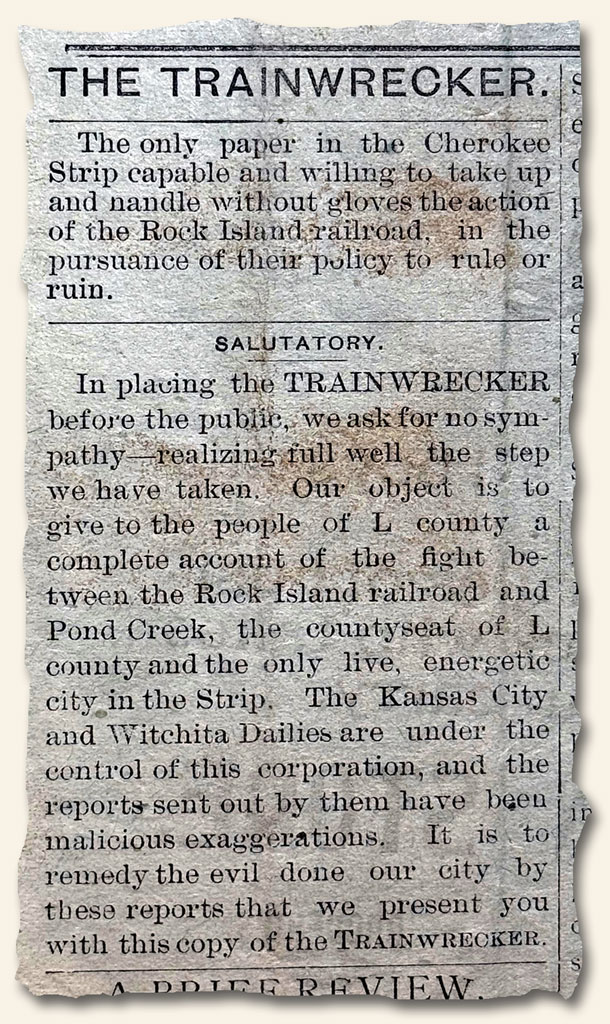
What if Germany won World War I ?
October 6, 2025 by TimHughes · Leave a Comment
Some of the more intriguing newspapers are “futuristic” editions, those printed with a dateline 50 or 75 years in the future, filled with reports of what editors presumed life would be like at that time. They always prove to be very interesting reading.
We recently came upon a “what if” newspaper. Although we’ve had a few, including use of the atomic bomb on American cities, or end-of-the-world scenarios, this issue of “The Liberty Blast” (shown below) is printed as if Germany had won World War I. Although the dateline reads “April 29, 1920”, the editorial on page 2 notes that it was published on April 29, 1918, before World War I had come to an end.
The reporting is fascinating. See the many photos for what the editors thought could have happened. The page 2 editorial in this edition–the first any only of this title–was meant to: “…awaken in the hearts and minds of those who read it a realization of those horrors of a great world war…near to American shores…”.
An interesting issue to read. One of the many treasures to be discovered in the pursuit of this fascinating hobby!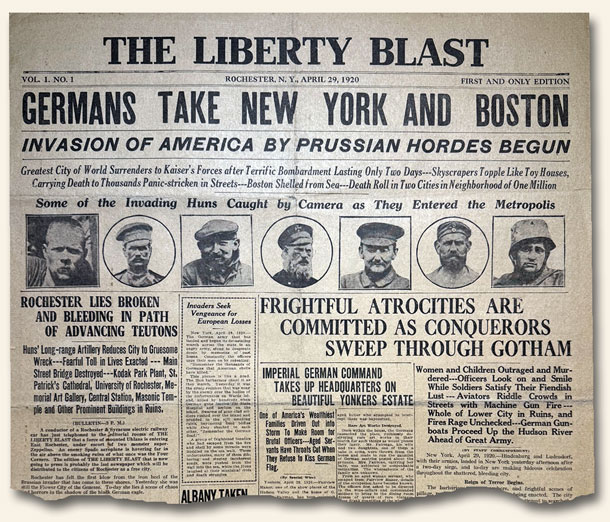
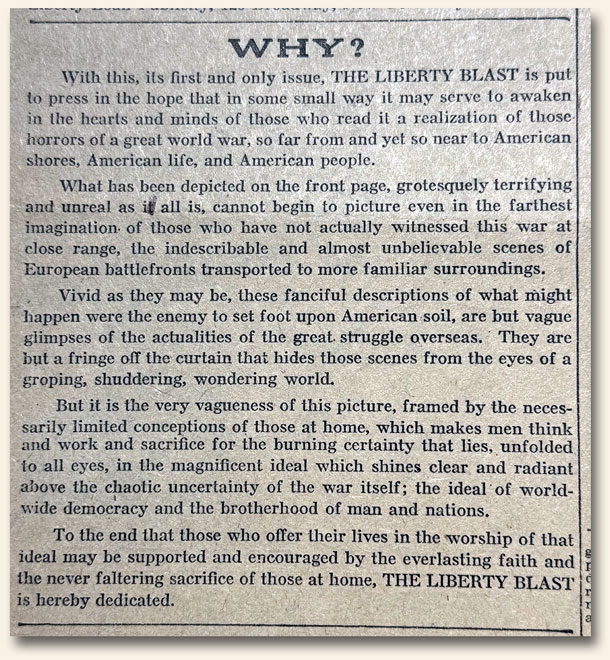
The reason I collected it: our most remote newspaper yet…
September 15, 2025 by TimHughes · Leave a Comment
In addition to newspapers with historical content, or graphic presentations, or among the smallest (or largest) possible, another “extreme” that has fascinated me has been those that are exceedingly remote. We have an issue or two of the “Alaska Forum” which is the northernmost American newspaper to be found, but our discovery of “The Penguin Post” from 1957 trumps it in terms of being as close to one of the poles as possible.
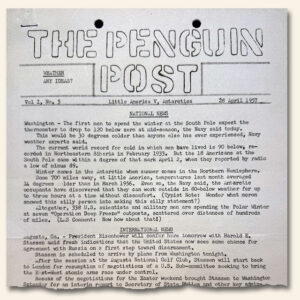 This is a fascinating “newspaper” from near the South Pole, published at “Little America V” in Antarctica. It has an intriguing history.
This is a fascinating “newspaper” from near the South Pole, published at “Little America V” in Antarctica. It has an intriguing history.
“Little America” was a series of Antarctic exploration bases from 1929 to 1958 located on the Ross Ice Shelf, south of the Bay of Whales. They were built on ice that is moving very slowly, the relative location on the ice sheet moves and eventually breaks off into an iceberg.
There were five such exploration bases, this being the last. Little America V was established on January 3, 1956, at Kainan Bay, some 30 miles east of Little America IV, as part of Operation Deep Freeze. Little America V served as the American base in the South Polar program in the International Geophysical Year, from July 1, 1957, to December 31, 1958. It was constructed by United States Navy Seabees in the three-month window before the Antarctic winter made construction nearly impossible. All of Little America V was constructed below the snow line in the ice, with individual living quarters, a generator room, a cafeteria, and ramps leading out at one end for tracked vehicles. This type of construction meant that none of those staying in Little America V had to go outdoors in the harsh winter when going from one section to another of the Antarctic town.
This–thus far–is assuredly the southernmost newspaper we have found.
A 49 year search comes to an end… The 1765 “Tombstone” issue…
September 1, 2025 by TimHughes · Leave a Comment
There are a number of iconic American newspapers that every collector desires, most are for content alone such as the Declaration of Independence, the Constitution, the assassination of Abraham Lincoln, etc.
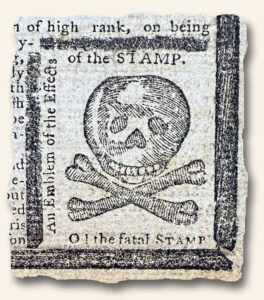 Not many are desired for both historical significance as well as graphic appeal, but such is the case with the Pennsylvania Journal of October 31, 1765. Having been aware of it for many years (photos are found in many high school history books), I had always been in the search for a genuine issue (beware: many reprints exist). I came close about 35 years ago when an institution, which had two in their collection, gave thought to exchanging one with me for an unknown Philadelphia newspaper I had discovered. Ultimately, they opted not to do the swap, so the search was back on.
Not many are desired for both historical significance as well as graphic appeal, but such is the case with the Pennsylvania Journal of October 31, 1765. Having been aware of it for many years (photos are found in many high school history books), I had always been in the search for a genuine issue (beware: many reprints exist). I came close about 35 years ago when an institution, which had two in their collection, gave thought to exchanging one with me for an unknown Philadelphia newspaper I had discovered. Ultimately, they opted not to do the swap, so the search was back on.
It ended earlier this year.
This particular edition, famously known as the “tombstone edition,” used striking visual and textual elements to express colonial outrage over the Stamp Act tax, which required many printed materials, including newspapers, to bear a revenue stamp. This tax directly impacted printers and publishers, placing a heavy economic burden on them and fueling widespread resistance.
As seen in the photos, the masthead featured a skull and crossbones, a powerful symbol representing the “death” of the press under the weight of the Stamp Act. Also, an engraving of a coffin appears at the bottom of the back page, captioned: “The last Remains of the PENNSYLVANIA JOURNAL Which departed this Life, the 31st of October, 1765, Of a Stamp in her Vitals, Aged 23 Years.”
Publisher William Bradford begins the issue with poignant commentary, including: “I am sorry to be obliged to acquaint my readers, that as The Stamp Act is fear’d to be obligatory upon us after the First of November ensuing (the fatal to-morrow) the publisher of this paper unable to bear the burthen, has thought it expedient to stop a while, in order to deliberate whether any methods can be found to elude the chains forged for us…”.
Published just one day before the Stamp Act’s enforcement, this edition cleverly voiced dissent without yet violating the law, making it a strategic act of defiance.
This “tombstone edition” of the Pennsylvania Journal captured this economic strain and transformed it into a public rallying cry.
This edition stands as a vivid example of how the colonial press used creativity to oppose British policies, contributing to the growing revolutionary sentiment. It underscores the critical role newspapers played in shaping public opinion and mobilizing opposition in the years leading up to the American Revolution.
While other newspapers also protested the Stamp Act, the Pennsylvania Journal’s dramatic tombstone imagery made it particularly memorable and influential. It galvanized public resistance, cementing its place as a powerful symbol of defiance in American history.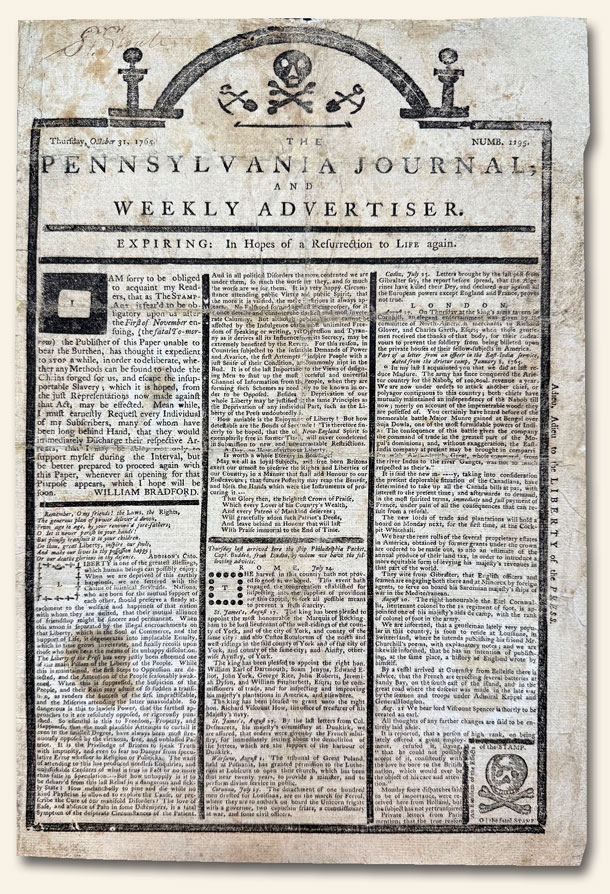
An historic broadside with a connection to early newspapers… revisiting “The Gerry-Mander”…
August 7, 2025 by TimHughes · Leave a Comment
Shown below the following video is a reposting of Timothy Hughes’ original post regarding “The Gerry-Mander”. We are revisiting the topic due to current events. We hope you enjoy.
Although we just discussed the historic broadside, “The Gerry-Mander”, a few days ago, since it was initially part of Timothy Hughes’ personal collection, we thought it might enjoy hearing from him directly. Enjoy.
From Tim…
Many years ago I had access to a very unusual broadside (single sheet, printed on one side only) titled: “Natural And Political History of THE GERRY-MANDER! In Two Chapters…..With Cuts.” Although it was not a newspaper, which was always my focus, a little investigation showed it had a newspaper collection. It would not be until many years later that I discovered how historically significant it really was.
“Gerrymander” is an interesting term that came into being in 1812 at a meeting of Federalist political leaders and newspapermen in Boston. Complaints about the efforts of their Republican opponents to rig state elections by altering voting districts led artist Elkanah Tisdale to add a head and wings to an outlined map of a new senatorial district in Essex County and name it the “gerrymander” after the leader of the Jeffersonians, Governor Elbridge Gerry. The cartoon shocked the public and proved very effective. Gerrymander has since become embedded in the political lexicon of America.
 This broadside we offer is described by dealer Barry Lawrence Ruderman as a “Rare political broadside featuring the first political cartoon in American history to visualize and satirize gerrymandering, one of the most enduring distortions of democratic representation…”.
This broadside we offer is described by dealer Barry Lawrence Ruderman as a “Rare political broadside featuring the first political cartoon in American history to visualize and satirize gerrymandering, one of the most enduring distortions of democratic representation…”.
As seen in the photos, this broadside pairs two woodcut maps with satirical letterpress text mocking the 1812 Massachusetts Senate redistricting law. The cartoon appeared in the Boston Gazette in March 1812, and quickly spread.
The left woodcut depicts the now-famous creature with wings, claws, and a serpent-like neck, labeling the towns it distorts. The right side features a straightforward district map of Essex County showing the two senatorial districts under the new law. The surrounding text is divided into “Natural History” and “Political History.” The first, reprinted from the Gazette, invents a monstrous genealogy for the gerrymander; the second details the law’s consequences—particularly how the Democratic-Republicans expanded their Senate majority from 21–19 to 29–11 despite losing the popular vote.
The American Antiquarian Society tentatively dates this broadside printing to between 1813 and 1822, the latter date coinciding with renewed controversy around redistricting. The cartoon here is virtually identical to the original Gazette version, suggesting either reuse of the block or a careful recutting of it.
Everything about this broadside makes this a landmark artifact of political commentary and electoral history in the United States.
It measures 18 by 20 inches, has minimal foxing, and is in nice condition. One dealer offers this very same broadside for $24,500.
From the Vault: Creating Harper’s Weekly engravings: a fascinating process…
July 21, 2025 by TimHughes · 14 Comments
 Harper’s Weekly issues of the 19th century remain among the more popular in our inventory, as the multiple engravings found in each issue document much of American history from 1857 through the end of the century. We have over 60,000 issues in inventory but still some dates are sold out as soon as they arrive. I suspect most of you have seen this title, but few may be aware of the interesting process of creating the prints in a timely manner.
Harper’s Weekly issues of the 19th century remain among the more popular in our inventory, as the multiple engravings found in each issue document much of American history from 1857 through the end of the century. We have over 60,000 issues in inventory but still some dates are sold out as soon as they arrive. I suspect most of you have seen this title, but few may be aware of the interesting process of creating the prints in a timely manner.
 The story of how Harper’s delivered this amazing product during the Civil War is a fascinating one, and I must give credit to www.sonofthesouth.net for much of detail.
The story of how Harper’s delivered this amazing product during the Civil War is a fascinating one, and I must give credit to www.sonofthesouth.net for much of detail.
The process started by the deployment of not only reporters but also artists to the battlefield. Some of the most renowned artists of the 1800’s got their start as illustrators for Harper’s Weekly, including Winslow Homer and Thomas Nast. These artists would sketch scenes of the battles that they witnessed and the sketches would then be dispatched back to Harper’s for publication in the upcoming papers.
In order to publish the artwork, the images first had to be carved onto a block of wood. But it would take too much time for a single engraver to carve an entire print, particularly given the timeliness of each issue. To provide the illustrations as quickly as possible, a very clever idea was developed. The illustration would be cut into 2 inch squares and each square would be engraved onto a different small block of wood by an assigned carver.
 By dividing the illustration up, each artist assigned to just a portion, a team of workers could carve a full page illustration in a short period of time. After the small blocks were completed they were then screwed together to form the overall illustration and a finishing engraver would provide final touches to be sure the pieces were perfectly aligned. This completed wood block was then used as a “master” to stamp the illustration onto all the newspapers being printed. If you look at a Harper’s engraving carefully you can often see where the blocks of wood were joined together.
By dividing the illustration up, each artist assigned to just a portion, a team of workers could carve a full page illustration in a short period of time. After the small blocks were completed they were then screwed together to form the overall illustration and a finishing engraver would provide final touches to be sure the pieces were perfectly aligned. This completed wood block was then used as a “master” to stamp the illustration onto all the newspapers being printed. If you look at a Harper’s engraving carefully you can often see where the blocks of wood were joined together.
It wasn’t until the 1890’s that the technology of printing caused the end of hand-done engravings for the pages of Harper’s and other illustrated periodicals. With the demise of this labor-intensive trade also came the end of some of the more beautiful works of art to be found on paper. They remain treasures today and hearken back to an era when artistry and long hours of work were an important part in providing the news.
(This post was originally published on March 23, 2009.)
Editors take note: be careful what accompanies a headline…
July 18, 2025 by TimHughes · 1 Comment
With so many newspapers flowing through our company every year, it would be no surprise that occasionally something very unusual would be noticed. Such is the case with the November 22, 1963 issue of THE ATLANTA JOURNAL, their “Second Extra”. This edition has a curious–if not macabre–combination of headline and photo.
As would be expected of an “Extra” of this date, the large & bold headline proclaims: “KENNEDY KILLED”, but immediately beneath it is a photo of a street sweeper pushing his trash cart. The cart has what appears to be the bottom half of a mannequin protruding from it, with the caption: “Sweeper Means What He Says”, as if related to the assassination report.
One might excuse the editor, for I’m sure that, in rushing this edition to the streets as quickly as possible, the planned headline was removed and the Kennedy death report was quickly inserted with little thought as to what else was scheduled above the fold that day. Indeed, the “Third Extra” has the same headline but a photo of the Kennedy motorcade immediately after the shooting.
This issue remains one of the more unique & “interesting” newspapers of the 20th century, and a great example to editors everywhere to be aware of headlines & unrelated photos that appear in close proximity.




